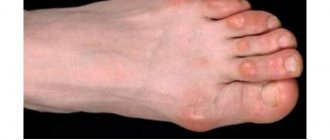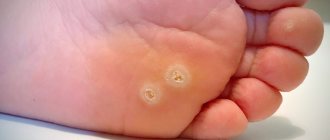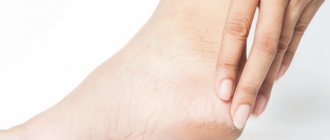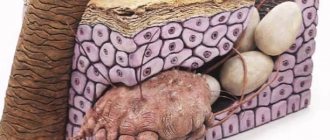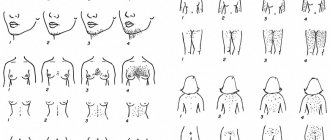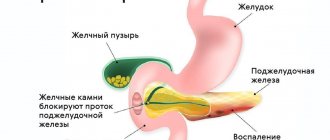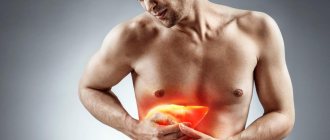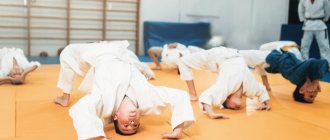A callus is a skin lesion small in size and depth that occurs from physical activity, sports, or wearing uncomfortable shoes. Calluses in the form of chafing often occur from tight, new shoes. The skin reacts to exposure with hyperkeratosis - excessive keratinization (thickening).
Dry calluses may not cause discomfort for a while, but usually hurt when pressed. It is advisable to immediately take measures to remove dead skin and heal tissue. If you do nothing, the problem will become deeper and wider in the literal sense of these words. In the future, tissue infection, suppuration, and related problems may arise.
For treatment, doctors can recommend various products in the form of gels, ointments and infusions, but the most effective and simple remedy is considered to be a patch against calluses, the advantages of which are:
- does not require special knowledge or special conditions for dressing;
- securely fixed on the callus;
- protects the skin from further damage, penetration of microbes, and development of infection;
- softens the stratum corneum for painless and quick removal;
- reduces pain;
- stimulates tissue regeneration;
- serves as a prevention of inflammation and cracks;
- the medicinal composition in the form of impregnation remains on the injured area and does not stain clothing, unlike ointment.
The medical supply store offers a wide selection of plasters, including waterproof, clear, and highly specialized ones. All that remains is to choose the appropriate option and follow the instructions for use.
Treatment of calluses and corns. Modern methods of therapy
Treatment of calluses is not the biggest problem of modern medicine.
But calluses cause inconvenience, and they just look ugly. Therefore, their competent removal determines the comfort of human life. Depending on the tissue structure, calluses are divided into:
- dry – normal roughening of the skin, without a cavity;
- aqueous - rubbed skin forms a cavity in which there is a colorless, watery, odorless liquid;
- blood - the same cavity, only with blood content;
- calluses with a core are the same dry calluses in which, due to constant irritation, a compaction has formed in the thickness of the tissue (core) in the same place.
Corns are diagnosed separately. The difference between them and calluses is that:
- they are usually smaller in size;
- “built” from a compacted center, around which there is a circular (circular) inflamed area of skin;
- painful even with slight pressure.
Removing corns, like calluses, is not a complicated procedure.
Timely diagnosis
Treatment and diagnosis of growths must be carried out in a timely manner. Otherwise, various complications may occur. The development of an infectious process at the site of callus formation is diagnosed.
If pain, redness and swelling occur, it is recommended to consult a doctor, as this indicates the development of an infection.
If the pathology is not treated in a timely manner, infection may develop in the surrounding tissues. If the patient has diabetes or blood diseases, this can lead to rapid infection of the entire body.
Formations, in accordance with the characteristics of their appearance, are divided into several types. Regardless of this, it is recommended to treat the formations in a timely manner, which will eliminate the possibility of complications.
Anatomical and physiological essence of calluses
To successfully treat calluses, you need to understand why they occur.
The skin is designed in such a way that it is not afraid of external irritants (chemical, mechanical, thermal). And thanks to the regular proliferation of cells, it is able to quickly regenerate (old cells are rejected, new ones appear in their place).
But with prolonged mechanical action, friction, pressure, excessive irritation, the skin becomes rough and calluses appear. Most often they are formed due to permanent friction on the hands and feet. Although calluses are often observed on the elbows, tongue, gums and even in such unusual places as the male penis, labia in women, nipples and areas of skin under the nails.
More information about what atypical places calluses can form and what this means for the patient can be found on the pages of our website https://www.dobrobut.com/. Also on the site you will find other useful information about calluses and corns.
Causes of calluses
From the point of view of pathophysiology, a callus on the sole or finger is a local skin thickening (growth of cells) resulting from excessive thickening of the stratum corneum of the epidermis. It is a peculiar reaction of the body designed to protect the most vulnerable areas of the skin. There are several factors leading to the formation of local areas of calluses:
- prolonged friction or pressure on the skin;
- orthopedic pathologies: clubfoot, flatfoot, valgus deformity of the first / fifth finger, hammertoe deformity (may be present on all fingers except the thumb);
- consequences of injuries and surgical interventions;
- excessive dryness of the skin of the feet;
- metabolic disorder leading to increased keratinization (keratinization of epithelial cells);
- nail deformities.
In addition, callus on the heel and other parts of the foot can occur against the background of varicose veins, diabetes mellitus, atherosclerosis, fungal infections, etc.
Treatment of calluses, basic methods
You can get rid of roughening (callus) of the skin in different ways. Treatment for calluses depends on their type and severity. In the arsenal of doctors are:
- therapy with medications that “dissolve” skin roughness;
- anti-callus patches;
- surgical removal (excision);
- The most modern method is laser removal of calluses.
Removing calluses using surgical instruments is performed not only by surgeons, but also by podiatrists - specialized specialists who deal exclusively with the feet.
Traditional methods
If it is not possible to see a doctor or a beauty salon, you can try safe traditional medicine methods for treatment.
One of the most famous recipes that helps to effectively get rid of calluses is a compress of lard and crushed garlic. Apply this mixture to the damaged area overnight and tie tightly. First, your finger should be carefully steamed and thoroughly wiped dry. Instead of garlic and lard, you can use aloe and lemon juice; such components also have a beneficial effect on neoplasm. Treatment should be continued until the growth disappears.
Onions infused in vinegar help very well against calluses. The whole onion should be poured with table vinegar and left for 24 hours, then apply one scale at a time to the damaged area. You can also use grated raw potatoes, mashed brown bread, prunes boiled in milk. Infusions and decoctions of herbs - dandelion, coltsfoot, wormwood, plantain, string, calendula - also help well to get rid of the problem.
Treatment of dry calluses on toes and hands
If such calluses have appeared recently, they do not need to be excised. There is every chance that such calluses can be removed by using gels and creams with keratolytic properties - that is, those that prevent changes in skin cells, which causes its roughening.
Some of the most effective ingredients of these ointments and gels are:
- salicylic acid;
- benzoic acid.
Treatment of dry calluses on the toes (feet) and hands (palm of the hands) may take longer than in other locations. The reason is that the skin here becomes calloused more intensely and to a greater depth. To be more effective, the removal of dry calluses on the feet and hands should be preceded by softening them (achieved by simple immersion in liquid).
Prevention
In order to prevent calluses from appearing on the little toes, a person must constantly adhere to certain rules of prevention:
- When choosing shoes, it is recommended to ensure that they completely match your foot size.
- It is best to give preference to shoes that are made from natural fabric.
- Before putting on your shoes for the first time, it is recommended to use an antibacterial patch. It is applied to places where formations may appear.
- A fairly effective preventive remedy is a pencil, the action of which is aimed at combating calluses.
- If the patient's skin is unprotected, then it is not recommended for him to wear closed shoes.
- The choice of socks and tights must be approached responsibly. They must exactly match your foot size.
- If you have a tendency to sweaty feet, it is recommended to constantly combat this pathological condition. In this case, talc is used, as well as various powders.
- Women are advised to regularly change shoes with high heels and thin soles.
- A person should constantly take care of their feet. For this purpose, hygiene procedures are regularly carried out, and special creams are used.
- If your feet are frequently injured, it is recommended to use special orthopedic shoes.
This video will tell you how to cure calluses on your little finger at home:
Timely and proper prevention of calluses will eliminate the possibility of their formation.
Calluses in the area of the little toes appear quite often. A person can develop various types of formations in this place. In order to ensure proper treatment, it is necessary to determine the type of callus. For the purpose of treating formations, folk recipes or pharmaceutical preparations are used.
Treatment of dry calluses with a rod
In this case, the surgical method is more effective, since it is technically impossible to lubricate the roughened core deep in the tissue with keratolytic ointments or gels in order to soften it.
Treatment of dry calluses with a core is a small surgical operation in compliance with the principles of asepsis, that is, with the treatment of the surgical field and the doctor’s gloves with antiseptics. Local anesthesia is mandatory, especially if the callus is old and it is assumed that the rod is deeply embedded.
Callus removal proceeds as follows:
- First, the callus itself is excised;
- Next, a neat incision is made in depth;
- Through it, the clamp grasps the rod and removes it.
It is easier to remove a callus on a toe with a rod than on the heel, because the length of the rod will not be long and the cut will not be deep.
Removing callus using drilling
This procedure can be carried out in a pedicure salon.
During the manipulation, a special device resembling a drill is used.
The procedure does not require the use of anesthesia.
Since it is not accompanied by pain.
Drilling/excision of callus areas is carried out using special attachments.
An antibacterial ointment is first placed in the deepening of the callus to prevent the development of the inflammatory process.
For the first few days, the patient may feel minor discomfort, which goes away on its own and does not require treatment.
Dry callus is removed using a similar method, but provided that it is not neglected.
The drilling procedure has certain disadvantages:
- If the rod is located deep enough, this manipulation may be ineffective. Often several manipulations are required to completely remove the callus.
- In the process of drilling out the keratinized area of the dermis, damage to healthy skin is possible. The procedure requires a highly qualified specialist.
- This type of callus removal is a contact type of procedure, which means it is accompanied by an increased risk of infection.
What does lack of treatment lead to?
Many reviews from victims indicate that they regret their late request for qualified help. Initially, you can get by with relatively inexpensive methods for removing the stratum corneum, but if the process is delayed, you can endure until core lesions occur.
It may immediately seem that even deep-seated lesions do not pose significant problems for general well-being, but over time they provoke pronounced pain when pressed. When walking, the patient's gait will change so as to have less impact on the unhealthy surface.
Several weeks of painful walking will result in improper distribution of the load on the knees, ankles and smaller joints of the feet. This leads to the launch of an extensive inflammatory process, which, in the worst case scenario, will also “give” arthritis and arthrosis.
Additionally, the constantly inflamed cap of the callus will affect your well-being, exacerbating a more acute pain syndrome. To prevent this, you should immediately seek help to excise the infected area using radical methods.
Types of deletions
Any professional specialized clinic provides clients with several options to choose from to get rid of this defect. After an initial examination, studying a medical card with a medical history and listening to complaints, the doctor will tell you which method is best. It is also worth paying attention to the fact that treatment with liquid nitrogen or other modern techniques is much less traumatic than classics of the genre such as surgery. But if the patient has to neutralize the entire callus field at once, or he has a low pain threshold, then he will be offered to use local anesthesia.
Before administering medications, medical staff are required to question the patient about a possible allergic reaction or conduct an allergy test. This will avoid the possibility of developing anaphylactic shock.
Today, the possibilities of cosmetology make it possible to get rid of unsightly and harmful growths in three main ways:
- drilling;
- laser exposure;
- cryodestruction.
The first point involves using a special cutter with which you can remove the rod. The main device here is a device for hardware pedicure. After successful root extraction, the cavity is filled with anti-inflammatory or antifungal drugs.
Laser treatment is based on the use of carbon dioxide radiation, which is characterized by painlessness and bloodlessness. The rays quickly burn out the source of the problem, simultaneously destroying pathogens, fungi or viruses that have accumulated nearby. Since the beam has a narrow focus, there is no need to worry about the doctor accidentally hitting healthy tissue. Another advantage of laser technology is the almost zero probability of relapse in the same place, since the rays burn out the roots down to the last millimeter.
Cryodestruction works a little differently, which is based on the use of liquid nitrogen. Thanks to the product, it is possible to influence the keratinized cells so that they do not exfoliate and pull the old core along with them.
